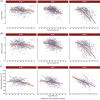Targeted proteomic biomarker profiling using NULISA in a cohort enriched with risk for Alzheimer's disease and related dementias
- PMID: 40318118
- PMCID: PMC12046973
- DOI: 10.1002/alz.70166
Targeted proteomic biomarker profiling using NULISA in a cohort enriched with risk for Alzheimer's disease and related dementias
Abstract
Introduction: Targeted proteomic assays may be useful for diagnosing and staging Alzheimer's disease and related dementias (ADRD). We evaluated the performance of a 120-marker central nervous system (CNS) NUcleic acid Linked Immuno-Sandwich Assay (NULISA) panel in samples spanning the Alzheimer's disease (AD) spectrum.
Methods: Cross-sectional plasma samples (n = 252) were analyzed using NULISAseq CNS panel from Alamar Biosciences. Receiver-operating characteristic (ROC) analyses demonstrated the accuracy from NULISAseq-tau phosphorylated at threonine 217 (pTau217) in detecting amyloid (A) and tau (T) positron emission tomography (PET) positivity. Differentially expressed proteins were identified using volcano plots.
Results: NULISAseq-pTau217 accurately classified A/T PET status with ROC areas under the curve of 0.92/0.86; pTau217 was upregulated in A+, T+, and impaired groups with log2-fold changes of 1.21, 0.57, and 4.63, respectively, compared to A-. Of interest, TAR DNA-binding protein 43 (TDP-43) phosphorylated at serine 409 (pTDP43-409) was also upregulated in the impaired group and correlated with declining hippocampal volume and cognitive trajectories.
Discussion: This study shows the potential of a targeted proteomics panel for characterizing brain changes pertinent to ADRD. The promising pTDP43-409 findings require further replication.
Highlights: The NULISAseq pTau217 assay was comparable to the Simoa pTau217 assay, both utilizing the ALZpath antibody, in detecting amyloid positron emission tomography (PET) positivity, each with areas under the curve greater than 90%. Nineteen proteins were differentially expressed in participants with mild cognitive impairment (MCI) compared to those who were unimpaired. Markers of non-AD proteinopathies such as pTDP43-409, oligomeric alpha-synuclein, and huntingtin (HTT), were among those upregulated in MCI. High levels of plasma pTDP43-409 were associated with worsening hippocampal atrophy and cognitive decline, clinical indicators of limbic-predominant age-related TDP-43 encephalopathy (LATE), compared to those with low pTDP43-409.
Keywords: Alzheimer's disease and related dementias; NULISA; pTDP43; pTau217; plasma biomarkers.
© 2025 The Author(s). Alzheimer's & Dementia published by Wiley Periodicals LLC on behalf of Alzheimer's Association.
Conflict of interest statement
H.Z. has served at scientific advisory boards and/or as a consultant for Abbvie, Acumen, Alector, Alzinova, ALZPath, Amylyx, Annexon, Apellis, Artery Therapeutics, AZTherapies, Cognito Therapeutics, CogRx, Denali, Eisai, LabCorp, Merry Life, Nervgen, Novo Nordisk, Optoceutics, Passage Bio, Pinteon Therapeutics, Prothena, Red Abbey Labs, reMYND, Roche, Samumed, Siemens Healthineers, Triplet Therapeutics, and Wave; has given lectures in symposia sponsored by Alzecure, Biogen, Cellectricon, Fujirebio, Lilly, Novo Nordisk, and Roche; and is a co‐founder of Brain Biomarker Solutions in Gothenburg AB (BBS), which is a part of the GU Ventures Incubator Program (outside submitted work). B.B.B. has consulted for New Amsterdam Pharma, Cognito Therapeutics, and Merry Life Biomedical, and is co‐founder of Cognovance (outside submitted work). S.C.J. has served on scientific advisory boards for ALZPath and Enigma Biomedical. N.A.C. has done consulting for New Amsterdam Pharm. The following authors reported no financial or non‐financial disclosures: Ramiro Eduardo Rea Reyes, Rachael E. Wilson, Rebecca E. Langhough, Rachel L. Studer, Erin M. Jonaitis, Julie E. Oomens, Elizabeth M. Planalp, and Sanjay Asthana. Author disclosures are available in the Supporting Information.
Figures




Update of
-
Targeted Proteomic Biomarker Profiling Using NULISA in a cohort enriched with risk for Alzheimer's Disease and Related Dementias.medRxiv [Preprint]. 2024 Nov 29:2024.11.28.24318162. doi: 10.1101/2024.11.28.24318162. medRxiv. 2024. Update in: Alzheimers Dement. 2025 May;21(5):e70166. doi: 10.1002/alz.70166. PMID: 39649596 Free PMC article. Updated. Preprint.
References
MeSH terms
Substances
Grants and funding
LinkOut - more resources
Full Text Sources
Medical

